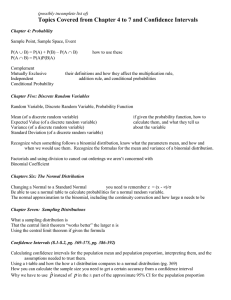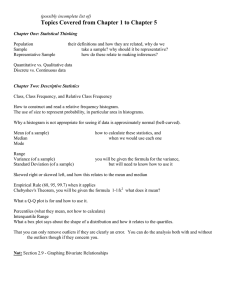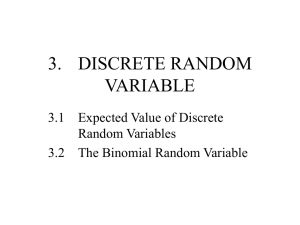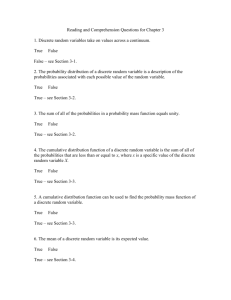Random variable (RV)--a variable that assumes numerical values
advertisement
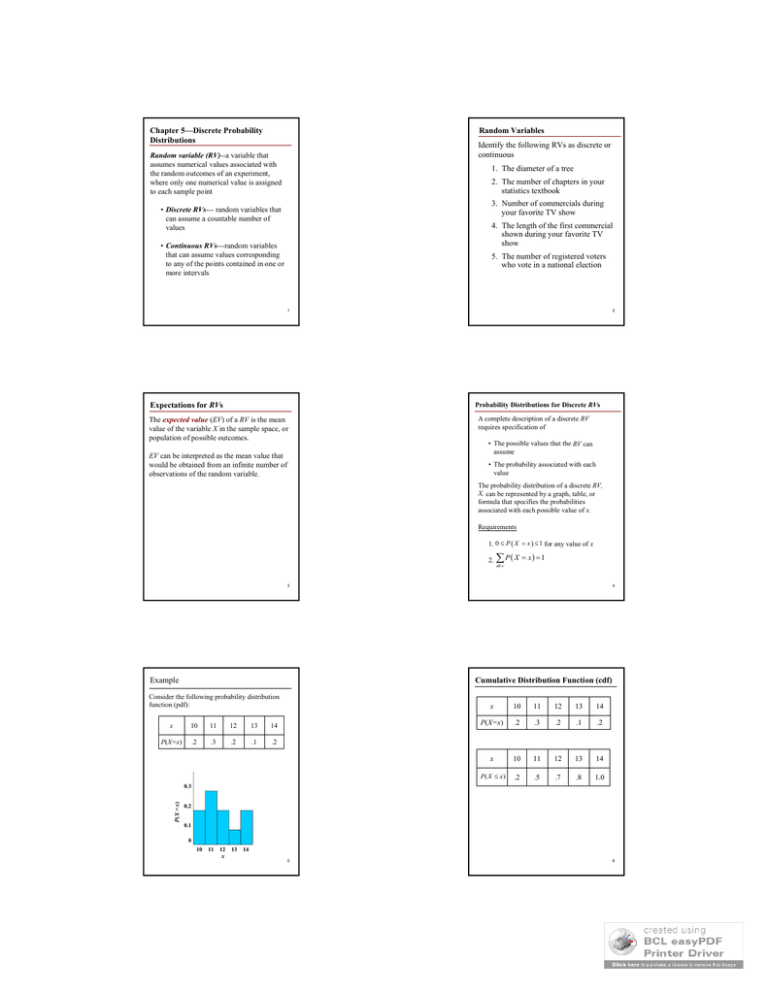
Chapter 5—Discrete Probability
Distributions
Random Variables
Identify the following RVs as discrete or
continuous
Random variable (RV)--a variable that
assumes numerical values associated with
the random outcomes of an experiment,
where only one numerical value is assigned
to each sample point
1. The diameter of a tree
2. The number of chapters in your
statistics textbook
3. Number of commercials during
your favorite TV show
• Discrete RVs--- random variables that
can assume a countable number of
values
4. The length of the first commercial
shown during your favorite TV
show
• Continuous RVs---random variables
that can assume values corresponding
to any of the points contained in one or
more intervals
5. The number of registered voters
who vote in a national election
1
Expectations for RVs
2
Probability Distributions for Discrete RVs
The expected value (EV) of a RV is the mean
value of the variable X in the sample space, or
population of possible outcomes.
EV can be interpreted as the mean value that
would be obtained from an infinite number of
observations of the random variable.
A complete description of a discrete RV
requires specification of
• The possible values that the RV can
assume
• The probability associated with each
value
The probability distribution of a discrete RV,
X, can be represented by a graph, table, or
formula that specifies the probabilities
associated with each possible value of x.
Requirements
1. 0 P X x 1 for any value of x
2.
P X x 1
all x
3
Example
4
Cumulative Distribution Function (cdf)
Consider the following probability distribution
function (pdf):
x
10
11
12
13
14
P(X=x)
.2
.3
.2
.1
.2
x
10
11
12
13
14
P(X=x)
.2
.3
.2
.1
.2
x
10
11
12
13
14
P( X x )
.2
.5
.7
.8
1.0
P(X = x)
0.3
0.2
0.1
0
10 11 12
x
13 14
5
6
1
Summary Calculations for Discrete RVs
Standard Deviation for Discrete RVs
The mean, or expected value, of a discrete
RV is determined by its probability
distribution
The standard deviation of a discrete RV is
equal to the square root of the variance:
2
E X xi P xi
all x
The variance of a discrete RV is
2
2
2 V X E X xi P xi
This quantifies how spread out the possible
values of a discrete RV might be, weighted by
how likely each value is to occur.
all x
Calculator formula:
2 xi2 P xi 2
all x
7
8
Expected Values for Discrete RVs
Variance for Discrete RVs
Example from Mathematical Statistics with
Applications, Mendenhall et al, 1981, p. 99
Example from Mathematical Statistics with
Applications, Mendenhall et al, 1981, p. 99
(continued)
Given the probability distribution
of Y, find the mean,
y P(Y = y)
variance and SD for Y
0
.125
1
.25
2
.375
3
.25
4
2
2
Y2 E Y yi P yi
i 1
0 1.75 .125 1 1.75 .25
2
2
2 1.75 .375 3 1.75 .25
2
2
0.9375
Y Y2 0.9375 0.97
4
Y E Y yi P yi
i 1
0 .125 1 .25 2 .375 3 .25
1.75
9
10
Rare Event Rule
Example
If, under a given assumption, the probability
of a particular observed event is extremely
small, we conclude that the assumption is
probably not correct.
Based on past results found
in the Information Please
Almanac, there is a 0.1818
probability that a baseball
World Series contest will
last four games, a 0.2121
probability that it will last
five games, a 0.2323
probability that it will last
six games, and a 0.3737
probability that it will last
seven games. Is it unusual
for a team to “sweep” by
winning in four games?
• Range rule of thumb: 2
• Use probabilities
Unusually high number of successes
P(x or more) 0.05
Unusually low number of successes
P(x or fewer) 0.05
11
Let Y =
number of
games played
in a world
series
y
4
P(Y = y)
.1818
5
.2121
6
.2323
7
.3737
12
2
Binomial Random Variables
Binomial Random Variables--Example
Characteristics of a binomial experiment
1. The experiment consists of n identical
(fixed) trials
Example
Record the sequence of heads and tails in 3
tosses of an unfair coin where the P(H) = .6
and the P(T) = .4. We are interested in the
distribution of the number of tails.
2. The trials are independent
3. The experiment results in a dichotomous
response; i.e., there are only two possible
outcomes on each trial. One outcome is
denoted by S (success) and the other by F
(failure)
4. The probability of S, denoted as p,
remains the same from trial to trial. The
probability of F, denoted as q, is equal to
1 – p.
What is n, the number of trials?
Are the trials identical?
Are the trials independent?
What is S?
What is X?
The binomial random variable, X, is the
number of S’s in n trials
13
14
Example (continued)
The Binomial Probability Distribution
How many possible outcomes are there?
Number of outcomes = 23= 8
Possible outcomes are:
n
P X x p x q n x
x
x 0,1,2,,n
where
P(HHH) = 0.6 x 0.6 x 0.6 = 0.216
P(HHT) = 0.6 x 0.6 x 0.4 = 0.144
P(HTH) = 0.144
P(THH) = 0.144
P(HTT) = 0.6 x 0.4 x 0.4 = 0.096
P(THT) = 0.096
P(TTH) = 0.096
P(TTT) = 0.4 x 0.4 x 0.4 = 0.064
HHH
HHT
HTH
THH
HTT
THT
TTH
TTT
X
P(X)
0
1
2
p probability of success on a single trial
q 1- p
n number of trials
x number of successes in n trials
n
n!
x x! n x !
3
0.216 0.432 0.288 0.064
15
16
The Binomial Probability Distribution
The Binomial Probability Distribution
Mean, Variance and SD for a Binomial RV
For the tossing three coins example we can
calculate various quantities:
Mean: np
3 2
32
2
1
P X 2 .4 1 .4 3.4 .6 .288
2
Variance: npq
2
SD:
npq
X np 3(.4) 1.2
V X npq 3(.4)(.6) 0.72; X 0.72 0.85
17
18
3
Generic Example: n = 6; p = 0.4
Table A-1,
page 769
in Triola
Can calculate various quantities:
6 0
60
6
P X 0 .4 1 .4 11 .6 .0467
0
6 1
61
5
P X 1 .4 1 .4 6.4 .6 .1866
1
6 2
62
2
4
P X 2 .4 1.4 15 .4 .6 .3110
2
Can also calculation cumulative
probabilities:
P X 2 P X 0 P X 1 P X 2
.3110 .1866 .0467
.5443
P X 2 1 P X 2
1 .5443
.4557
19
TI 83/84 binompdf(n, p, x) and binomcdf( )
2nd
Press
[DISTR]
Press ALPHA A for binompdf or
ALPHA B for binomcdf or
scroll through the list and press enter
20
Example
Consider the discrete probability distribution:
X
10
12
18
20
P(X)
.2
.3
.1
.4
Let n = 6 and p = 0.4.
Calculate , 2 , and
To find P(X = 3) use binompdf(6, .4, 3)
.27648
What is P x 15 ?
To find individual probabilities for more than
one value of X at a time use
binompdf(6, .4, {3, 4}) {.27648 .13824}
Calculate 2
To find P(X ≤ 3) use binomcdf(6, .4, 3) .8208
What is the probability that X is in the
interval 2 ?
To find P(X < 3) use
binomcdf(6, .4, 2) .54432
To find P(1 ≤ X ≤ 3) use
binomcdf(6, .4, 3) – binomcdf(6, .4, 0)
.774144
21
22
Example
Problem 4.47 from McClave and Sincich, 9th
edition, pg. 200
A Federal Trade Commission (FTC) study of the
pricing accuracy of electronic checkout scanners
at stores found that one of every 30 items is
priced incorrectly. Suppose the FTC randomly
selects five items at a retail store and checks the
accuracy of the scanner price of each. Let X
represent the number of the five items that is
priced incorrectly.
a) Show that X is a binomial RV.
b) Use the information in the FTC study to
estimate p for the binomial experiment.
c) What is the probability that exactly one of
the five items is priced incorrectly by the
scanner?
d) What is the probability that at least one of
the five items is priced incorrectly by the
scanner?
e) What is the probability that X is in the
interval 2 ?
23
4
